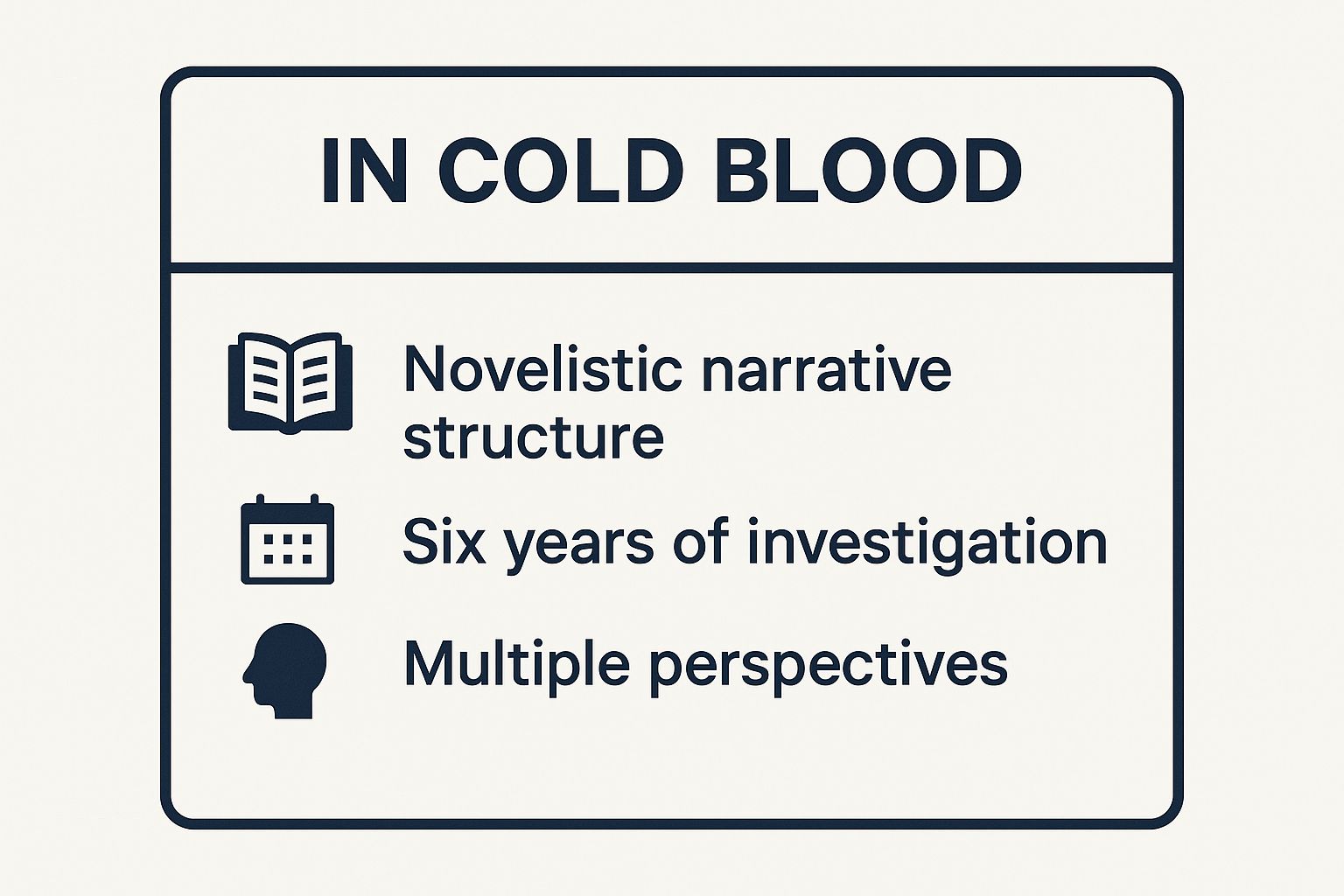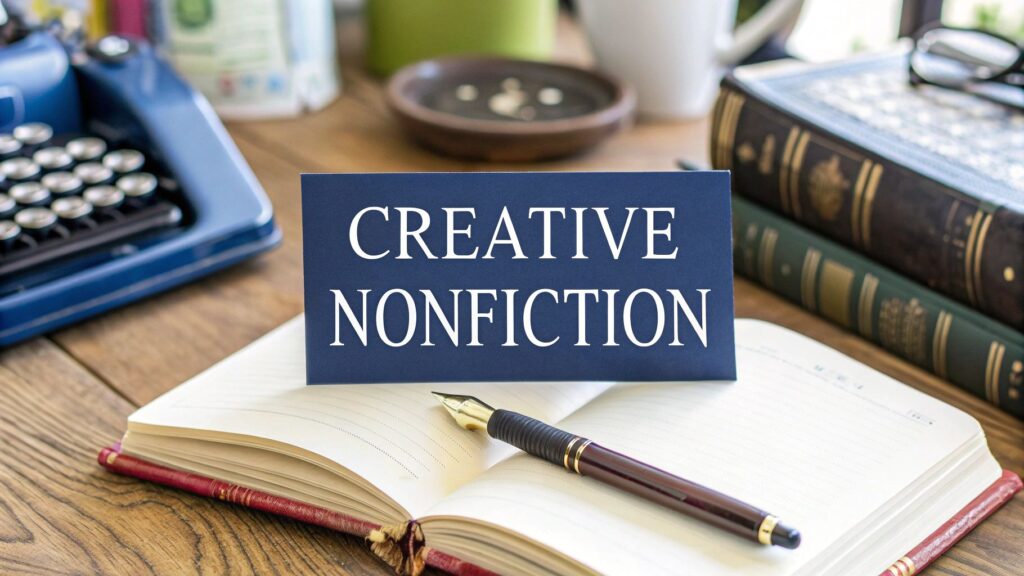Creative non-fiction bridges the gap between factual reporting and the art of storytelling. It proves that real-life events, when told with literary flair, can be just as gripping, moving, and memorable as any great novel. By applying narrative techniques like character development, scenic construction, and a distinct authorial voice to true stories, writers can transform raw information into a powerful, immersive experience. This genre isn't about inventing facts; it's about presenting them in a way that resonates on a deeply human level. Understanding how to master this form is crucial for any author wanting to make their true stories unforgettable.
This article moves beyond simple summaries to provide a strategic breakdown of landmark works. We will analyze a core example of creative non fiction from each selected book, dissecting the specific tactics the author used to achieve their effect. For each entry, you'll find:
- Strategic Analysis: A close look at how the author crafted a specific scene or passage.
- Tactical Insights: Pinpointing the replicable literary devices at play.
- Actionable Takeaways: Concrete methods you can apply to your own writing immediately.
From Truman Capote’s groundbreaking "non-fiction novel" to Cheryl Strayed’s introspective memoir, this guide is designed to equip you with practical tools to elevate your own storytelling. Let's explore how these masters turned truth into art.
1. In Cold Blood by Truman Capote
Truman Capote’s In Cold Blood is a foundational example of creative non fiction, a work that shattered the boundaries between journalism and literature. Published in 1966, it details the real-life 1959 murders of the Clutter family in Holcomb, Kansas. Capote labeled his creation a "nonfiction novel," signifying a new genre that applied the rich, immersive techniques of fiction to factual events.
The book’s power comes from its narrative structure. Instead of a dry, chronological report, Capote weaves a multi-perspective story that builds suspense and deepens emotional impact. He reconstructs scenes, develops characters, and uses dialogue to bring the story to life, making the reader feel like an observer to the unfolding tragedy. This approach demonstrated that true stories could be as compelling and artistically rendered as any great novel.
Strategic Breakdown
Capote’s primary strategy was exhaustive, immersive research combined with a novelist's toolkit. He spent six years on the project, conducting hundreds of interviews with everyone involved, from law enforcement to local residents and, most notably, the killers themselves, Richard Hickock and Perry Smith. This deep dive allowed him to craft a dual narrative, alternating between the victims' ordinary lives and the perpetrators' twisted journey.
Key Tactic: Capote’s use of a shifting third-person omniscient perspective was revolutionary for nonfiction. It allowed him to enter the minds of different characters, revealing their thoughts and motivations-a technique previously reserved for fiction. He constructed this internal access from thousands of pages of notes and interview transcripts, creating a psychological depth rarely seen in journalism.
Replicable Insights for Writers
For authors looking to apply these methods, the core lesson is the synthesis of rigorous fact-gathering and artful storytelling.
- Actionable Takeaway: Before writing a single creative sentence, build an unshakeable factual foundation. Capote’s literary flourishes were only possible because he had meticulously documented every detail. Your creative interpretation must be rooted in verifiable truth.
- When to Use This Approach: This method is ideal for long-form narrative nonfiction, particularly true crime, historical accounts, or biographies where you have access to extensive source material like letters, diaries, or interview subjects.
The following infographic highlights the core elements of Capote's groundbreaking process.

These points underscore the immense dedication required to blend journalism with literary art. The entire book writing process for a nonfiction novel demands a commitment to both factual accuracy and narrative craft, a balance Capote masterfully achieved.
2. The Year of Magical Thinking by Joan Didion
Joan Didion’s The Year of Magical Thinking stands as a monumental example of creative non fiction, showcasing the power of memoir to dissect profound personal tragedy with intellectual rigor. Published in 2005, the book chronicles the year following the sudden death of her husband, John Gregory Dunne, an event that occurred while their daughter was in a coma. Didion uses her distinct, precise prose to navigate the disorienting landscape of grief.
The book’s emotional force comes from its unflinching honesty and analytical lens. Didion refuses to sentimentalize her loss; instead, she scrutinizes it, examining her own irrational thoughts-the "magical thinking" of the title-with a reporter's detachment. This fusion of raw emotional experience with intellectual inquiry creates a universally resonant exploration of mourning, memory, and the struggle to find meaning in the face of sudden chaos.
Strategic Breakdown
Didion’s core strategy is the juxtaposition of intense personal vulnerability with cool, journalistic observation. She meticulously documents her experience while simultaneously researching medical literature and psychological studies on grief. This creates a compelling tension between the chaotic, emotional reality of loss and the human attempt to impose order and understanding upon it.
Key Tactic: Didion employs a recursive, non-linear structure that mirrors the obsessive and cyclical nature of grieving. She revisits key moments, phrases, and images, creating a spiral narrative. This technique allows the reader to experience the psychological state of grief directly, where memory is not a straight line but a looping, fragmented process of re-evaluation and shock.
Replicable Insights for Writers
For writers tackling deeply personal subjects, Didion’s work offers a masterclass in maintaining authorial control while exploring overwhelming emotion.
- Actionable Takeaway: Use research as an anchor. When writing about personal trauma or intense emotional states, grounding the narrative in external, factual information (medical, historical, or scientific) can provide structure and a necessary counterpoint to subjective experience. This balance prevents the work from becoming purely sentimental.
- When to Use This Approach: This method is highly effective for trauma-informed memoirs, personal essays about illness or loss, and any narrative where the author's internal psychological state is the central focus. It is ideal when you want to transform a singular experience into a universal one.
3. The Immortal Life of Henrietta Lacks by Rebecca Skloot
Rebecca Skloot’s The Immortal Life of Henrietta Lacks is a landmark example of creative non fiction that masterfully blends science journalism, biography, and social history. Published in 2010, the book tells the story of Henrietta Lacks, a poor Black tobacco farmer whose cells, taken without her knowledge in 1951, became one of the most important tools in medicine. Skloot intertwines the scientific journey of the immortal "HeLa" cells with the personal, often painful, story of the Lacks family.

The book's brilliance lies in its braided narrative structure. Skloot seamlessly moves between three distinct threads: the life of Henrietta and her family, the scientific history of the HeLa cells and their impact on modern medicine, and her own decade-long journey to uncover the story. This narrative technique allows her to explore complex themes of medical ethics, race, class, and faith from multiple angles, making difficult scientific concepts accessible and deeply human.
Strategic Breakdown
Skloot's primary strategy was patient, relationship-based investigative journalism. She spent over a decade earning the trust of the Lacks family, particularly Henrietta's daughter, Deborah. This long-term commitment was essential not only for gathering information but for understanding the deep emotional and ethical dimensions of the story. She combined this personal approach with meticulous scientific and historical research.
Key Tactic: Skloot’s use of a dual-protagonist narrative, positioning herself and Deborah Lacks as co-investigators, is a powerful device. By making her own process of discovery part of the story, she provides a relatable entry point for the reader. This allows her to guide the audience through complicated scientific and ethical terrain, asking the questions the reader would ask and sharing in the emotional discoveries alongside the Lacks family.
Replicable Insights for Writers
For authors tackling complex, multi-layered topics, the core lesson is the power of a human-centered, braided narrative.
- Actionable Takeaway: When dealing with technical or abstract subjects, find the human story at its core. Skloot didn't just write about cells; she wrote about the family they came from. Ground your narrative in personal experience to make it relatable and emotionally resonant.
- When to Use This Approach: This method is perfect for science writing, historical investigations, or any topic where you need to connect a big, impersonal subject (like medical research or economic policy) to its real-world human impact. It is particularly effective when the writer's own journey of discovery is integral to the story.
The following video provides more context on the story behind the book.
These points demonstrate how empathy and narrative structure can transform complex information into a compelling story. Exploring these kinds of tips for writing a book can help any writer tackle challenging but important subjects with grace and impact.
4. Dispatches by Michael Herr
Michael Herr’s Dispatches is a landmark example of creative non fiction that redefined war reporting. Published in 1977, it documents his experience as a correspondent for Esquire magazine during the Vietnam War. Herr abandoned the pretense of detached objectivity, instead delivering a visceral, subjective account that captured the war's psychological and sensory chaos.
The book's power stems from its revolutionary style. Herr blends reporting with stream-of-consciousness, soldier slang, and fragmented narratives that mirror the fractured reality of combat. He immerses the reader directly into the fear, paranoia, and dark humor of the soldiers on the ground. This highly personal, impressionistic approach showed that a true story’s deepest truth could be conveyed not just through facts, but through feeling and atmosphere.
Strategic Breakdown
Herr’s core strategy was to use radical subjectivity as a journalistic tool. He fully embedded himself within the culture of the grunts, adopting their language and perspective to report on the war from the inside out. He used literary techniques not just to describe events, but to evoke the internal, often surreal, experience of living through them. The fragmented structure of the book itself is a narrative choice, rejecting a linear timeline in favor of a collage of memories, sounds, and intense moments.
Key Tactic: Herr employed a "New Journalism" or "gonzo" approach, placing his own consciousness and sensory input at the center of the narrative. By chronicling the war through the lens of rock and roll, drug culture, and film references, he connected the conflict to the counter-culture of the era, making it comprehensible to a generation alienated from traditional reporting.
Replicable Insights for Writers
For authors wanting to channel this immersive style, the lesson is to trust subjective experience as a valid form of truth-telling.
- Actionable Takeaway: Fully immerse yourself in the environment and culture of your subject. Pay close attention to authentic language, slang, and shared cultural touchstones. Don’t just report what happens; translate the feeling of what happens onto the page.
- When to Use This Approach: This method is powerful for writing about intense, disorienting, or subcultural experiences where the psychological reality is as important as the factual one. It is ideal for memoir, immersive journalism, and narratives about trauma or conflict.
5. The Electric Kool-Aid Acid Test by Tom Wolfe
Tom Wolfe's The Electric Kool-Aid Acid Test is a high-voltage example of creative non fiction that plunged readers directly into the heart of 1960s counterculture. Published in 1968, the book chronicles the psychedelic journey of author Ken Kesey and his followers, the Merry Pranksters, as they traverse America in a wildly painted school bus. Wolfe’s work became a landmark of the "New Journalism" movement, which applied literary techniques to factual reporting.
The book’s genius lies in its stylistic bravado. Wolfe didn’t just report on the Pranksters’ experiences; he attempted to replicate the sensory overload and fractured consciousness of an acid trip through his prose. He used free association, onomatopoeia, and unconventional punctuation to capture the chaotic, vibrant energy of the movement. This radical approach proved that a true story’s narrative style could be as experimental and impactful as its subject matter.
Strategic Breakdown
Wolfe’s core strategy was deep immersion fused with a revolutionary writing style that mirrored his subjects' state of mind. He embedded himself with the Merry Pranksters, not as a detached observer but as a participant-reporter, absorbing the slang, attitudes, and psychedelic ethos of the group. This allowed him to write from a perspective that felt authentic and deeply informed, capturing the very texture of the subculture.
Key Tactic: Wolfe’s use of "status-life" details was central to his method. He meticulously documented the clothes, music, gestures, and speech patterns of the Pranksters. This focus on the minutiae of their world allowed him to construct a rich, detailed portrait of their culture from the inside out, making the abstract counterculture movement tangible for the reader.
Replicable Insights for Writers
For writers inspired by Wolfe's audacious style, the main lesson is to let the subject dictate the form. The style should serve the story, not just be an exercise in flair.
- Actionable Takeaway: Match your writing voice to your subject's world. If you are documenting a high-energy, unconventional subculture, don't be afraid to break grammatical rules and experiment with prose to evoke that specific feeling. Your writing style becomes part of the reporting.
- When to Use This Approach: This immersive, stylistically bold approach is perfect for cultural journalism, memoirs about intense experiences, or any nonfiction project where the subject's internal state and unique environment are central to the story. It is especially effective for capturing a specific moment in time.
6. Wild by Cheryl Strayed
Cheryl Strayed’s Wild is a powerful example of creative non fiction that masterfully intertwines physical journey with emotional healing. Published in 2012, the memoir recounts Strayed’s 1,100-mile solo hike along the Pacific Crest Trail following her mother’s sudden death and the subsequent unraveling of her life. The book became a cultural phenomenon, inspiring countless readers to confront their own wilderness, both literal and metaphorical.

Its success lies in its raw vulnerability and resonant structure. Strayed doesn't just tell us she's healing; she shows us through the grueling, present-tense narrative of her hike, punctuated by poignant flashbacks. This dual timeline mirrors the very nature of processing grief, where the past constantly intrudes upon the present until it can be integrated and understood.
Strategic Breakdown
Strayed's core strategy is using a physical ordeal as a central, propulsive metaphor for an internal, psychological journey. The challenges of the trail, from an oversized backpack she nicknames "Monster" to encounters with rattlesnakes and losing her boots, directly reflect her internal battles with grief, guilt, and self-destruction. The forward momentum of the hike provides a clear narrative arc that contains the messiness of her past.
Key Tactic: The book’s genius is its structural braid, weaving the "now" of the trail with the "then" of her memories. A moment of physical struggle on the trail triggers a flashback to a specific memory, giving the backstory emotional context and preventing it from feeling like an info-dump. This makes the reader an active participant in Strayed’s process of recollection and reconciliation.
Replicable Insights for Writers
Writers can learn from Strayed’s model for structuring a narrative of transformation. The key is to anchor abstract emotional growth in concrete, sensory experience.
- Actionable Takeaway: Identify a central, forward-moving "engine" for your story, like a journey, a project, or a countdown. Use this present-tense storyline as the spine, and hang memories and backstory off it like ribs. This creates narrative tension and makes abstract themes tangible.
- When to Use This Approach: This structure is perfect for memoirs about recovery, healing, or personal transformation. It works exceptionally well when a significant life event or challenge serves as a catalyst for looking back and making sense of one's past.
The process of crafting such an interwoven narrative requires careful planning and the right set of writing tools for authors to keep track of timelines and thematic connections.
7. The Devil Wears Prada by Lauren Weisberger
Lauren Weisberger’s The Devil Wears Prada serves as a fascinating example of creative non fiction disguised as a novel. The book is a roman à clef, a French term for a "novel with a key," in which real people and events are cloaked in fiction. It draws heavily from Weisberger’s personal experience as an assistant to legendary Vogue editor-in-chief Anna Wintour, providing an insider’s exposé of the high-stakes fashion industry.
While sold as fiction, the book’s immense cultural impact stems from its perceived authenticity. Weisberger uses the narrative framework of a novel to document the grueling, often surreal, realities of working for a powerful and demanding boss. She blends factual emotional truth and specific, recognizable industry details with fictionalized characters and plot points, creating a work that functions as a deeply personal memoir and a sharp cultural critique.
Strategic Breakdown
Weisberger’s core strategy was to use personal experience as the raw material for a universally relatable story. She transformed her specific, niche job into a narrative about toxic work environments, ambition, and the sacrifice of personal values for professional gain. This approach allowed her to share a compelling true-to-life story while maintaining a degree of creative and legal distance. The fictional veneer gave her the freedom to shape events for maximum narrative impact.
Key Tactic: The roman à clef model was Weisberger's masterstroke. By thinly veiling her characters, particularly the iconic Miranda Priestly, she created a guessing game for readers and insiders alike. This generated enormous buzz and speculation, making the book a cultural event while simultaneously protecting her from direct repercussions. The story's power lay in its plausibility, not its proven factuality.
Replicable Insights for Writers
For authors with a powerful personal story set in a specific industry, Weisberger’s method offers a blueprint for sharing it without writing a straightforward memoir.
- Actionable Takeaway: Identify the universal themes within your unique experience. Weisberger focused on the boss-from-hell dynamic, a theme that resonates far beyond the fashion world. Frame your personal story around a central, relatable conflict to give it broad appeal.
- When to Use This Approach: This method is perfect when your true story involves well-known individuals or sensitive workplace situations where a direct, nonfictional account could lead to legal trouble or professional fallout. It is also effective for writers who want to heighten the drama and streamline the narrative of their own life experiences.
7 Examples of Creative Nonfiction Compared
| Title | Implementation Complexity 🔄 | Resource Requirements 🔄 | Expected Outcomes 📊 | Ideal Use Cases 💡 | Key Advantages ⭐ |
|---|---|---|---|---|---|
| In Cold Blood | High – Requires extensive investigation, multiple perspectives, literary techniques | Very high – 6 years research, many interviews | Deep psychological insight, compelling nonfiction novel | True crime storytelling, literary journalism | Pioneered creative nonfiction; highly engaging narrative |
| The Year of Magical Thinking | Medium – Non-linear memoir with research integration | Moderate – Research into grief psychology | Profound meditation on grief and trauma, universal insight | Memoir writing, trauma and grief exploration | Combines personal narrative with analytical clarity |
| The Immortal Life of Henrietta Lacks | High – Multi-threaded narrative blending science, history, biography | Very high – Over a decade research | Raises ethical awareness, makes complex science accessible | Science writing, medical ethics, social justice topics | Thorough research, bridges science with social issues |
| Dispatches | Medium – Impressionistic, fragmented structure | Moderate – Immersion in war environment | Captures psychological chaos of combat | War reporting, subjective journalism, trauma literature | Vivid, immersive war narrative challenging traditional norms |
| The Electric Kool-Aid Acid Test | Medium-High – Experimental style, cultural immersion | Moderate – Immersive cultural participation | Captures 1960s counterculture vividly | Cultural criticism, New Journalism, psychedelic era documentation | Innovative prose, strong cultural immediacy |
| Wild | Medium – Dual timeline, honest first-person narrative | Moderate – Personal experience and research | Emotional healing through physical journey, relatable memoir | Adventure memoirs, healing narratives, nature writing | Accessible writing blending adventure with emotional depth |
| The Devil Wears Prada | Low-Medium – Fictionalized exposé with insider perspective | Low – Based on personal experience | Entertaining industry critique, cultural commentary | Workplace narratives, roman à clef, social satire | Engaging storytelling with insider access, broad appeal |
Your True Story is Waiting: How to apply these lessons
The journey through these iconic works reveals a powerful truth: creative nonfiction is not just about recounting facts. It is about crafting an immersive experience that resonates with the universal human condition. Each example of creative nonfiction we’ve explored serves as a masterclass, demonstrating that the tools of fiction, such as character development, scenic construction, and narrative tension, are essential for bringing true stories to life.
From Truman Capote’s groundbreaking "nonfiction novel" approach in In Cold Blood to Cheryl Strayed’s raw, introspective journey in Wild, the common thread is a deep commitment to narrative truth. These authors did not simply report events; they inhabited them, wrestled with their complexities, and translated them into compelling stories that grip the reader's heart and mind.
Key Takeaways for Your Own Writing
To begin applying these lessons, focus on these core principles drawn from the examples:
- Embrace Your Unique Voice: Tom Wolfe’s flamboyant New Journalism and Joan Didion’s precise, cool-headed prose show that your authorial voice is your most powerful tool. It’s not just what you say, but how you say it that creates a memorable narrative.
- Structure is Your Story's Skeleton: Whether it’s Rebecca Skloot’s dual-timeline investigation in The Immortal Life of Henrietta Lacks or Lauren Weisberger’s classic hero’s journey in The Devil Wears Prada, a strong narrative framework is non-negotiable. As you begin to craft your own compelling true story, remember that even factual narratives benefit from a well-organized presentation. Learn how to unleash the power of structure in writing to organize your narrative effectively.
- Mine the Details for Emotional Truth: Michael Herr didn't just report on the Vietnam War; he captured its sensory chaos and psychological toll in Dispatches. The smallest, most specific details, from the smell of jungle rot to the sound of helicopter blades, are what create authenticity and emotional impact.
Your Actionable Next Steps
Feeling inspired? The next step is to move from analysis to action. Start by selecting a single technique from one of the authors we’ve discussed.
Could you try writing a scene from your own life using Capote’s "fly-on-the-wall" perspective? Or perhaps journal about a challenging experience with Strayed’s unflinching honesty? The goal is not to imitate but to integrate. By experimenting with these proven strategies, you begin to build your own toolkit, discovering which methods best serve the story you need to tell.
Every great work of creative nonfiction began as a single, powerful idea, a true story waiting to be told. The examples in this article are not just models to admire; they are roadmaps to follow. They prove that with dedication to craft, strategic narrative design, and an honest voice, your personal experiences can be shaped into a work that informs, moves, and endures. Your true story is waiting.
Ready to transform your manuscript into a professionally published book? The team at BarkerBooks provides comprehensive ghostwriting, editing, and publishing services to help authors navigate every step of the journey. Visit BarkerBooks to learn how we can bring your creative nonfiction project to life.
